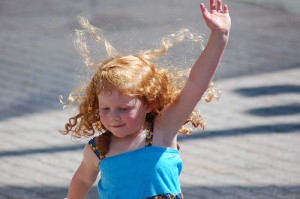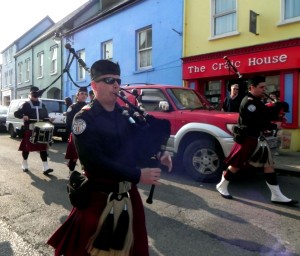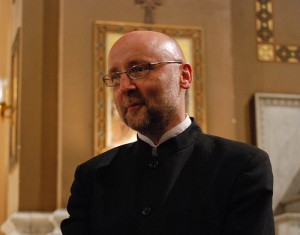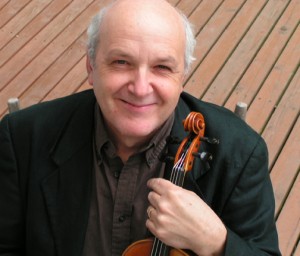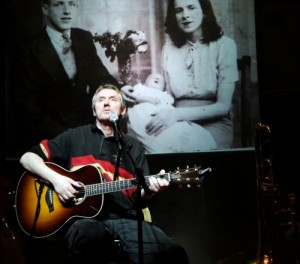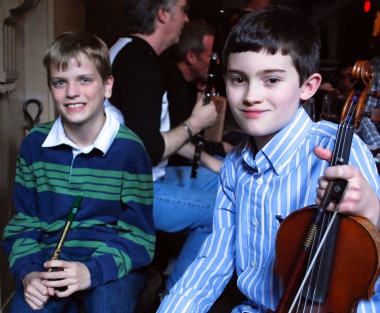
Keegan Loesel, left, and Alexander Weir: Headed to the Fleadh
The table in front of the musicians is crowded with pint glasses in various shades of beer and tenses of the word, “drink.” But the youngest musicians at the Sunday session at Philadelphia’s The Plough and the Stars pub aren’t imbibing. After all, fiddler Alex Weir is only 12, tin whistle player and piper, Keegan Loesel is 11, and little Emily Safko, barely bigger than her Irish harp, is 9.
Still, they spend so much time playing in bars, Emily’s mother Amy says that when her third grader assembled a poster for her “spotlight” day at Cranberry Pines Elementary School in Medford, NJ, “it was full of pictures of her in pubs.”
Of course, they’re Irish pubs which are usually family friendly and the weekly sessions–well, think of them as free music lessons. Sessions (seisiuns, in Irish) have long been a traditional way for Irish traditional players to jam informally and maybe learn a new technique or a tune or two, often in the dark corner of a pub or a cottage kitchen.
There’s little tolerance for the novice player at most sessions, and although one adult musician at the Sunday session refers to the three as “the leprechauns,” he says it respectfully. These “leprechauns” are solid trad musicians who are all going to Ireland in August—one for the second time—to compete in the All-Ireland Fleadh Cheoil na hÉireann in Cavan Town.
Alex Weir, of West Chester, is a fleadh veteran. He got his start on the violin as many American children do—with Suzuki, a method developed in Japan that puts tiny violins in the hands of children as young as three and nurtures them in a positive environment where they’re expected to pick up music as naturally as they acquire language. Pretty soon, the violin became a fiddle–Alex wanted to learn some Irish tunes to play accompaniment for his dance school friends at Do Cairde School of Irish Dance in West Chester. “Once he started learning the fiddle there was no turning back,” says Alex’s father, Carl.
For several years, Alex has been part of Next Generation, a group of young players organized by veteran Irish musicians Dennis Gormley, Kathy DeAngelo, and Chris Brennan-Hagy. They meet the second Sunday of every month for a session at the Philadelphia Irish Center and have performed at the Garden State Discovery Museum, the Philadelphia Ceili Group Traditional Irish Music and Dance Festival, and the Celtic River Festival in Gloucester, NJ, among other venues. The group has produced another veteran fleadh competitor—9-year-old Haley Richardson from Pittsgrove, NJ, who has been playing fiddle since she was three.
Alex, who continues to study classical violin, is an Irish music sophisticate: He doesn’t just play Irish tunes on the fiddle, he plays “Sligo-style,” like his teacher, Brian Conway of New York. Sligo style is brisk and elaborate—featuring what’s called ornamentation (trills, slides, and extra notes) with both left and right hands. It’s the lively, toe-tapping, uplifting style that most Americans associate with Irish music. “It picks you up,” says Alex, during a lull in the Sunday session. “I feel happy all the time when I play it.” Competing in this year’s Comhaltas Ceoltori Eireann Mid-Atlantic Fleadh, he came in first in fiddle slow airs under 12, first in duets with Emily Safko, and second in fiddle under 12 (Haley Richardson took first in that category).
Keegan Loesel was only three when a CD his mom had popped into the car changed his life. “I picked out this noise I heard on the CD. I found out later it was a uilleann pipe [pronounced ill-in, a small, Irish bagpipe],” explains Keegan, a fifth grader at Hillendale Elementary School in Chadds Ford, PA. At three, he was barely bigger than a set of pipes, but he told his mom, “I want to do that.”
“I thought that would go away, but it didn’t,” says Keegan’s mother, Lynette. “Two years later, I emailed a pipe maker to find out how to get him started and they told me to get him a whistle.”
It wasn’t long before Keegan was taking lessons on both the pipes and the tin whistle. He got his first set of pipes in January. This is his first year qualifying for the All-Irelands on whistle—not bad for a kid who was so shy about performing in public that his sister offered him money to play a tune at a session. “He did it and as we were going out the door he turned to us and said, ‘When are we coming back?’” says Lynette. That’s when she knew he was hooked.
Like Keegan, Emily Safko got off to an early start—and with an instrument that really was bigger than she was. She comes from a musical household—her father, Greg, is a classically trained pianist—that isn’t very Irish, “I think I’m Irish, but we don’t really know,” says Amy, her mom. “I don’t know exactly where it came from, but she started asking for a harp when she was four. I think she’d seen a harpist at Longwood Gardens.”
Emily begs to differ. She says she was bitten by the harp bug at 3. She got her first Irish harp at the age of 6 and at 9, travelled to the Mid-Atlantic Fleadh in Parsnippany, NJ, and came in first in harp slow air under 12, first in duets (with Alex) and second place in harp under 12. Kathy DeAngelo is her teacher. Emily says she takes every opportunity to play. “I got to play the harp at my school in first grade, second grade, and third grade,” she says, her child’s harp leaning against her shoulder. She’s even becoming a regular at the Irish session at the Treehouse Café in Audubon, NJ. “It’s like practice for the fleadh,” she says.
Like getting to Carnegie Hall, as the old joke has it, making it to the fleadh takes practice, practice, practice. But it also takes fundraising, fundraising, fundraising.
Keegan and Alex have taken to the streets of West Chester where they employed that age-old Irish musician money-making technique—busking–a couple of weeks ago to the accompaniment of passing cars. They also have some more official events coming up:
On Sunday, June 5, starting at 5 PM, Alex and Keegan will be playing with teacher/performer Mary Kay Mann at the BBC Tavern and Grill at 4019 Kennett Pike, Greenville, DE. If you write IRELAND on your bill, the BBC Tavern will donate 10 percent of those purchases to the boys’ travel fund.
On Friday, June 3 and Friday, July 1, you can see the boys outside the Longwood Art Gallery, 200 East State Street, Kennett Square, during the First Friday Kennett Square Art Strolls.
On Saturday, July 23, they’ll be performing at the West Chester Growers Market from 9:30 to 11:30 AM at the corner of North Church and West Chestnut streets in downtown West Chester.
If you’d like to hold a benefit for any of these talented young musicians, email lymabusi@yahoo.com.
See our photos of all of the children here.

